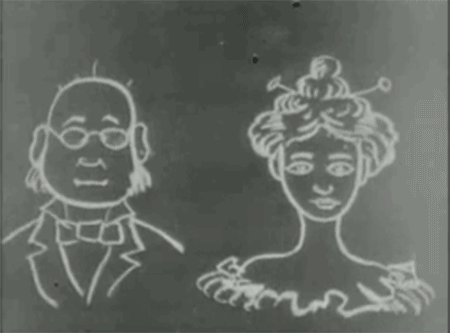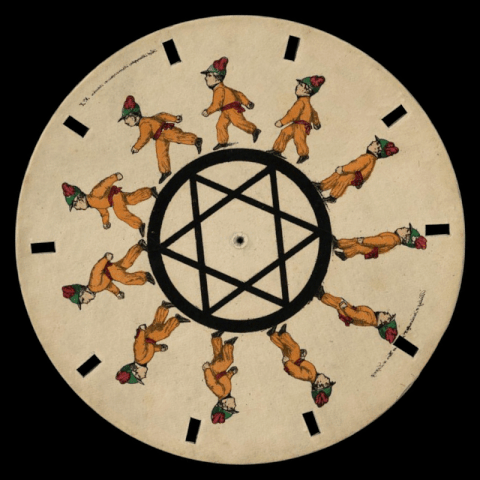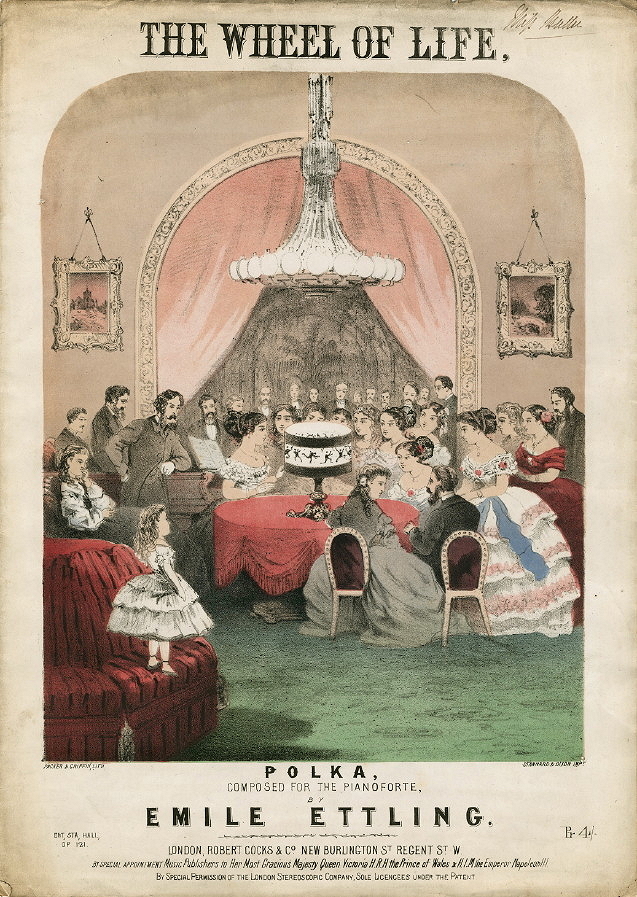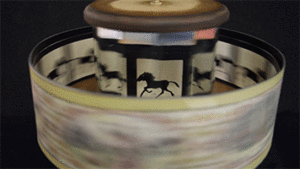Sequential Art, Optical Toys and Early Animation
This week, we will trace the origins of animation all the way back to prehistoric paintings, and see how artists and inventors created the illusion of movement, paving the way for the advent of modern cinema.
Jump to the different sections with the links below:
Animated Cave Paintings | Shadow Puppets | Magic Lanterns | Optical Toys | Émile Reynaud’s Théâtre Optique | Eadweard Muybridge’s Locomotion Studies | Arthur Melbourne-Cooper: Pioneer of stop-motion | John Stuart Blackton’s Lighting Sketches | George Méliès: Pioneer of VFX | The End of an Era | Assignment
Animated Cave Paintings
Cave paintings, such as the ones found in the Chauvet and Lascaux Caves in France (15,000 BCE), already display humans’ interest in capturing movement: several drawings are superimposed to create the impression that the buffaloes, horses, etc. are moving.

“[Paleolithic] artists at Lascaux used fire to see inside caves, but the glow and flicker of flames may also have been integral to the stories the paintings told. (…) Whatever tales may have been told inside Lascaux have been lost to history, but it is easy to imagine a person moving their fire-lit lamp along the walls as they unraveled a story step-by-step, using the darkness as a frame for the images inside a small circle of firelight.(…) What’s more, a flickering flame in the cave may have conjured impressions of motion like a strobe light in a dark club. In low light, human vision degrades, and that can lead to the perception of movement even when all is still, says Susana Martinez-Conde, the director of the Laboratory of Visual Neuroscience at the Barrow Neurological Institute in Phoenix, Ariz. The trick may occur at two levels; one when the eye processes a dimly lit scene, and the second when the brain makes sense of that limited, flickering information. (…) The end result for early humans who viewed cave paintings by firelight might have been that a deer with multiple heads, for example, resembled a single, animated beast.” (from “Early Humans Made Animated Art: How Paleolithic artists used fire to set the world’s oldest art in motion” by Zach Zorich)
Marc Azema, a Prehistorian specializing in cave art, demonstrated the effect of the flickering light by sequencing the superimposed cave drawings:

Shadow Puppets
We will see several examples of puppet animation in the coming weeks. The technique’s origins can be traced to the long and multi-cultural tradition of shadow puppetry.
“Shadow puppetry is an ancient form of storytelling and entertainment which uses flat articulated cut-out figures which are held between a source of light and a translucent screen or scrim. The cut-out shapes of the puppets sometimes include translucent color or other types of detailing. Various effects can be achieved by moving both the puppets and the light source. A talented puppeteer can make the figures appear to walk, dance, fight, nod and laugh. Shadow play is popular in various cultures, among both children and adults in many countries around the world. More than 20 countries are known to have shadow show troupes. Shadow play is an old tradition and it has a long history in Southeast Asia, especially in Indonesia, Malaysia, Thailand and Cambodia. It has been an ancient art and a living folk tradition in China, India, Iran and Nepal.(…) Shadow puppet theatre likely originated in Central Asia-China or in India in the 1st millennium BCE.” (from Wikipedia)

The video below (3 min) shows one of the last Chinese Masters of shadow puppetry work (to delve further into the history of Chinese shadow puppetry, visit this page).
Magic Lanterns
Magic Lanterns appeared in the seventeenth century, and remained a popular entertainment and information tool through the 19th century. They worked similarly to modern slide projectors: glass plates with images (painted or printed) were inserted behind a lens, backlit, and projected onto a wall or screen.
Magicians and entertainers used magic lanterns to enhance their performances. While some machines were permanently housed in theaters, many of them were portable enough to be taken on the road by itinerant artists who adapted their show for different audiences.

Magic lanterns were used for all sorts of contents, including fairy tales, phantasmagoria (ghost stories), news, sing-alongs, travel documentaries, religious education, scientific demonstrations etc. You can think of these presentations as precursors to cinema or Power Point presentations – depending on the subject and audience.
One of the most famous lanternists was the Belgian Étienne-Gaspard Robertson (1763 – 1837) who toured Europe with his Fantasmagorie shows and scientific demonstrations. The advertisement for his first performance in 1798 read: “Fantasmagorie … by citizen E-G. Robertson: apparitions of Spectres, Phantoms and Ghosts, such as must appear or could appear in any time, in any place and among any people. Experiments with the new fluid known by the name of Galvanism, whose application gives temporary movement to bodies whose life has departed. An artist noted for his talents will play the Harmonica.” (you can read more about E.-G. Roberston in “Robertson’s Fantastic Phantasmagoria, An 18th Century Spectacle of Horror” by Allison Meier)

Magic Lantern performances could also be brought into the home: “According to research conducted by Exeter’s John Plunkett, magic lanterns were a regular part of middle-class life, popping up during birthday parties, holidays and social gatherings. As Katy Scott reports for CNN, this meant that nearly 200 years before streaming services made it possible to delve into fantastical tales of fictional worlds and panoramic tours of Earth’s most stunning sights from the comfort of one’s own living room, sophisticated visions were commonly enjoyed in the Victorian home. Plunkett relied on Victorian newspaper advertisements to gauge the popularity and availability of the devices. As he tells Geggel, opticians, photographers and stationery suppliers started renting out magic lanterns during the mid-1800s, enabling Victorians to enjoy the visual spectacle at a reasonable price. “Hiring a lantern and slides was [initially] very much an expensive treat for the middle classes, especially if they wanted a lanternist too,” Plunkett says in a statement. “As the century went on it became much more affordable.” (from “Before There Was Streaming, the Victorians Had Magic Lanterns” by Meilan Solly)
The machines evolved over time and the simple hand painted slides started to be printed and mass-produced. Certain models even incorporated simple animations by overlapping slides, and/or using crank mechanisms. Chromatrope projections (see below) represent early forms of projected abstract animations.

Magic Lanterns were also massed produced as toys and were popular until the first half of the 2oth century when 35mm slides took over the market for home projections.

This video from the Ford Foundation (3 min) shows antique Magic Lanterns in action, and gives a good overview of the art form’s history:
Optical Toys
As scientific discoveries and medical advancement led to a better understanding of visual perception (see persistence of vision – week1), researchers developed motion devices to demonstrate these concepts. These objects also became popular toys for the home.
“A thaumatrope (“wonder turner”) is an optical toy that was popular in the 19th century. A disk with a picture on each side is attached to two pieces of string. When the strings are twirled quickly between the fingers the two pictures appear to blend into one.” – Wikipedia
“The phénakistiscope (“spindle viewer”) usually comes in the form of a spinning cardboard disc attached vertically to a handle. Arrayed radially around the disc’s center is a series of pictures showing sequential phases of the animation. Small rectangular apertures are spaced evenly around the rim of the disc. The user would spin the disc and look through the moving slits at the images reflected in a mirror. The scanning of the slits across the reflected images keeps them from simply blurring together so that the user can see a rapid succession of images that appear to be a single moving picture.” (from Herbert, Stephen. “Phenakistoscope Part Two”. www.stephenherbert.co.uk. Retrieved 19 July 2016.)
“A zoetrope (“wheel of life”) consists of a cylinder with cuts vertically in the sides. On the inner surface of the cylinder is a band with images from a set of sequenced pictures. As the cylinder spins, the user looks through the cuts at the pictures across. The scanning of the slits keeps the pictures from simply blurring together, and the user sees a rapid succession of images, producing the illusion of motion. The zoetrope works on the same principle as its predecessor, the phenakistoscope, but is more convenient and allows the animation to be viewed by several people at the same time. Instead of being radially arrayed on a disc, the sequence of pictures depicting phases of motion is on a paper strip. For viewing, this is placed against the inner surface of the lower part of an open-topped metal drum, the upper part of which is provided with a vertical viewing slit across from each picture. The drum, on a spindle base, is spun. The faster the drum is spun, the smoother the animation appears.” (from Wikipedia)
“The praxinoscope (“action viewer”) was an animation device, the successor to the zoetrope. It was invented in France in 1877 by Émile Reynaud (see below). Like the zoetrope, it used a strip of pictures placed around the inner surface of a spinning cylinder. The praxinoscope improved on the zoetrope by replacing its narrow viewing slits with an inner circle of mirrors, placed so that the reflections of the pictures appeared more or less stationary in position as the wheel turned. Someone looking in the mirrors would therefore see a rapid succession of images producing the illusion of motion, with a brighter and less distorted picture than the zoetrope offered.” (from Wikipedia)
While most of these optical toys aren’t produced anymore and have become collector’s items, flipbooks remain quite popular today. “A flipbook is a booklet with a series of images that very gradually change from one page to the next, so that when the pages are viewed in quick succession, the images appear to animate by simulating motion or some other change (…). The oldest known documentation of the flip book appeared on 18 March 1868, when it was patented by John Barnes Linnett under the name Kineograph (“moving picture”). They were the first form of animation to employ a linear sequence of images rather than circular (as in the older phenakistoscope).” -Wikipedia (the two examples below are from (from https://www.collectorsweekly.com/articles/flipping-out-over-handheld-movies/)
This video by “Ancient Magic Art Tools” (3 min) shows replicas of Victorian optical toys in action:
Émile Reynaud’s Théâtre Optique
“The Théâtre Optique” (“Optical Theatre”) is an animated moving picture system invented by Émile Reynaud and patented in 1888. From 28 October 1892 to March 1900 Reynaud gave over 12,800 shows to a total of over 500,000 visitors at the Musée Grévin in Paris. His “Pantomimes Lumineuses” series of animated films include “Pauvre Pierrot!” (see below) and “Autour d’une cabine”. (…) Reynaud acted as the projectionist and the show was accompanied by Gaston Paulin on the piano. Paulin had written the music especially for the shows, including a song that he sung as Pierrot’s serneade to Colombine in “Pauvre Pierrot!”. Occasionally two assistants would provide dialogue for the characters. The show was immediately successful with hundreds of visitors for the five daily shows. The entrance fee was 50 centimes, currently roughly equivalent to U.S. $5. (…) Reynaud’s Théâtre Optique predated Auguste and Louis Lumière’s first commercial, public screening of the cinematograph on 28 December 1895, which has long been seen as the birth of film.” (from Wikipedia).

Walt Disney made a short TV documentary (6 min) about Reynaud in 1955:
This video (5 min) by iconauta shows a color version of what a performance of “Pauvre Pierrot!” might have looked and sounded like for the audience at the time:
Eadweard Muybridge’s Locomotion Studies
Before the advent of photography, artists and scientists had little understanding of the way people and animals moved. The ability to break down motion through photography and to study the mechanics of movement was crucial for the development of animation.
The English photographer Eadward Muybridge (1830-1904) lived and worked most of his adult life in the USA. “An accomplished bookseller, inventor, and businessman, Eadweard Muybridge advanced both technical and aesthetic applications of the photography medium. (…) He devised techniques to freeze animal and human locomotion, to depict movement as sequences of still images, and to reanimate these in some of the first projected moving pictures. In 1878, working under the patronage of railroad baron Leland Stanford, Muybridge successfully photographed horses in motion, combining art and science to represent movements that were not visible to the eye. By 1887, when he published his masterpiece, “Animal Locomotion”, he had become one of the most influential photographers of his time, inspiring artists and scientists to look more closely at the nature of movement.” (from sfmoma.org)
This short documentary (4 min) from SF MoMA offers a good overview of Muybridge’s legacy:
Arthur Melbourne-Cooper:Pioneer of Stop-Motion
To this day, stop-motion animation is a popular storytelling medium. Early on, stop-motion was mostly used as “special effects” for live-action cinema, but Arthur Melbourne-Cooper (British. 1874-1961), a pioneer of the technique in Britain, created entirely animated shorts.
“Animated matches playing volleyball” (0:30 min)is one of three stop-motion promotional films Melbourne-Cooper created for Bryant & May matches circa 1899:
While Melbourne-Cooper made more than 30 films, only six of them survive, including “Dream of Toyland” (1907) (7 min) – an ambitious combination of live-action and animation sequences filmed in natural light, wherein toys come to life in a young boy’s dream (the animated sequence starts at around 3:07) :
John Stuart Blackton’s lighting sketches
“An important antecedent to the animated film, lightning sketches became popular on the vaudeville stage around the end of the nineteenth century. The lightning-sketch artist performed a narrative monologue while drawing on a large easel, creating images that rapidly transformed. Some of the earliest animated films captured these performances, adding film tricks such as double-exposure and stop motion, to create imagery that seemed to come to life and interact with the real world.” (from “Blackface Minstrelsy and the Rise of American Animation” by Nicholas Sammond).
James Stuart Blackton (1875-1941) was a well-known newspaper cartoonist who also performed lightning sketches in theaters before becoming a animator. His “Humorous Phases of Funny Faces” (1906) is one of the earliest examples of lightning-sketch on film. It includes several visual camera tricks, including reversed footage, and is considered as the first example of drawn animation created using multiple drawings to be screened in America. The appearance of Blackton’s hand acts as a reminder of the “magician” at work (and became a trope of silent-cinema referred to as the “hand of the artist”).

George Méliès: Pioneer of VFX
“Georges Méliès (1861 – 1938) was an early French experimenter with motion pictures, the first to film fictional narratives. When the first genuine movies, made by the Lumière brothers, were shown in Paris in 1895, Méliès, a professional magician and manager-director of the Théâtre Robert-Houdin, was among the spectators. The films were scenes from real life having the novelty of motion, but Méliès saw at once their further possibilities. He acquired a camera, built a glass-enclosed studio near Paris, wrote scripts, designed ingenious sets, and used actors to film stories. With a magician’s intuition, he discovered and exploited the basic camera tricks: stop motion, slow motion, dissolve, fade-out, superimposition, and double exposure. From 1899 to 1912 Méliès made more than 400 films, the best of which combine illusion, comic burlesque, and pantomime to treat themes of fantasy in a playful and absurd fashion. He specialized in depicting extreme physical transformations of the human body (such as the dismemberment of heads and limbs) for comic effect. (…) The commercial growth of the industry forced him out of business in 1913, and he died in poverty.” (from Britannica)
One of the most famous sequences in film history uses stop motion and is from Méliès’ famous film “A trip to the Moon” (1902) (13 min) (sequence around 6:00)
The End of an Era
As we’ve seen, the origins of animation are linked with society’s fascination with storytelling, novel technology, the occult, and scientific discoveries. While the novelty of animated “tricks” were a feature of turn-of-the-century performances and films, they fell out of fashion as cinema became a staple of modern culture in the 1910s and the length and narrative complexity of films increased.
ASSIGNMENT: Journal entry
Respond to the journal entry prompt(s) on this page.











